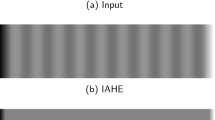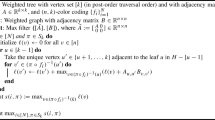Abstract
A multiresolution analysis of digital gray-level images is presented. A gray-level multi-scale framework is determined from two main assumptions: the gray scale is binary at the finest spatial resolution, and the gray levels of composed regions are obtained additively. In order to interrelate the gray-level histograms of the same image at different resolutions, probabilistic linear models are developed, which are then applied for estimation. Linear-optimization theory is used as a way of constructing such models. A general procedure for image processing is sketched, based on gray-level estimation. A versatile algorithm for nonlinear filtering is derived. Some examples of prospective applications are given.
Similar content being viewed by others
References
K.R. Castleman,Digital Image Processing. NJ: Prentice Hall, 1979.
J.M. Cibulskis and C. Dyer, “An analysis of node linking in overlapped pyramids,”IEEE Trans. on Systems, Man and Cybernetics, vol. SMC-14, pp. 424–436, 1984.
S.C. Clippingdale and R.G. Wilson, “Least-squares image estimation on a multiresolution pyramid,”Proc. ICASSP '89, pp. 1409–1412, 1989.
M. Garbooj, P. Haavisto and Y. Neuvo, “Recent advances in median filtering,”Communication, Control and Signal Processing (Proc. of Bilcon '90, E. Arikan, ed.), pp. 1378–1385. Amsterdam: Elsevier Science Publishers, 1990.
R.C. Gonzalez, “Image enhancement and restoration,” in:Handbook of Pattern Recognition Image Processing, San Diego, CA: Academic Press, 1986.
W.I. Grosky and R. Jain, “A pyramid-based approach to segmentation applied to region matching,”IEEE Trans. on Pattern Analysis and Machine Intelligence, vol. PAMI-8, pp. 639–650, 1984.
T.H. Hong and M. Shneier, “Extracting compact object using linked pyramids,”IEEE Trans. on Pattern Analysis and Machine Intelligence, vol. PAMI-6, pp. 229–236, 1984.
R. Jain and K. Aril,Fundamentals of Digital Image Processing. NJ: Prentice-Hall Int. Ed., 1989.
T. Lindeberg, “Scale-space for discrete images,”Contributions to the 6th Scandinavian Conference on Image Analysis, Report TRITA-NA-P8905 CVAP 61. Stockholm, Sweden: Royal Institute of Technology.
T. Lindeberg, “Scale-space for discrete signals,”IEEE Trans. on Pattern Analysis and Machine Intelligence, vol. PAMI-12, pp. 234–254, 1984.
J. Martínez-Aroza,Contribución al análisis y estimación en imágenes digitales mediante la teoría de la información, Ph.D. Thesis. Publicationes de la Universidad de Granada, October 1990.
J. Martínez-Aroza, J.J. Quesada-Molina and R. Román-Roldán, “A characterization of images through entropy-resolution diagrams,”Signal Processing V. Theories and Applications (Proceedings of EUSIPCO-90, Barcelona, Sept. 1990, Torres et al., eds.), pp. 1055–1058. Elsevier Science Publisher, 1990.
J. Martínez-Aroza, J.J. Quesada-Molina and R. Román-Roldán, “Estimation of images via conditional probabilities,”Communication, Control, and Signal Processing (Proceedings of the 1990 Bilkent Int. Conf. on “New Trends in Comm., Cont., and Sig. Pro.” Bilcon '90, Ankara, July 1990, E. Arikan, ed.), pp. 1378–1385. Amsterdam: Elsevier Science Publishers, 1990.
J. Martínez-Aroza, J.J. Quesada-Molina and R. Román-Roldán, “Image estimation through probabilistic methods,”Proceedings of the IV Symposium Nacional de Reconocimiento de Formas y Análisis de Imágenes, Granada, Sept. 1990. pp. 324–326.
J. Martínez-Aroza, J.J. Quesada-Molina and R. Román-Roldán, “Image processing methods based on linear models of interresolution dependence,”Proceedings of the China 1991 International Conference on Circuits and Systems, pp. 552–555, IEEE, 1991.
I. Pitas and A.N. Venetsanopoulos,Nonlinear Digital Filters. Principles and Applications. The Netherlands: Kluwer Academic Publishers, 1990.
R. Román-Roldán, J.J. Quesada-Molina and J. Martínez-Aroza, “Multiresolution estimation of gray-level histograms,”Pattern Recognition and Image Processing in Physics (Proceedings of the NATO ASI, Dundee (UK), August 1990, R. A. Vaughan, ed.), pp. 343–348, Bristol, UK: Adam Hilger, 1991.
R. Román-Roldán, J.J. Quesada-Molina and J. Martínez-Aroza, “Multiresolution-information analysis for images,”Signal Processing, vol. 24, pp. 77–91, July 1991.
M. Spann and R. Wilson, “A quad-tree approach to image segmentation which combines statistical and spatial information,”Pattern Recognition, vol. 18, pp. 257–269, 1985.
L. Takacs, “Combinatorics,” in:Handbook of Statistics 4, P. R. Krishnaiah and P. K. Sen, eds., pp. 123–173. Amsterdam: North-Holland Science Publishers, 1984.
A. K. C. Wong and M. A. Vogel, “Resolution-dependent information measures for image analysis,”Trans. IEEE on Systems, Man and Cybernetics, vol. SMC-7, Jan. 1977.
Author information
Authors and Affiliations
Additional information
This work was partially supported by grant TIC91-646 from the DGYCIT of the Spanish Government.
Rights and permissions
About this article
Cite this article
Martínez-Aroza, J., Román-Roldán, R. Probabilistic linear models for multiresolution estimation in gray-level images. Multidim Syst Sign Process 6, 7–35 (1995). https://doi.org/10.1007/BF00980143
Received:
Revised:
Issue Date:
DOI: https://doi.org/10.1007/BF00980143




